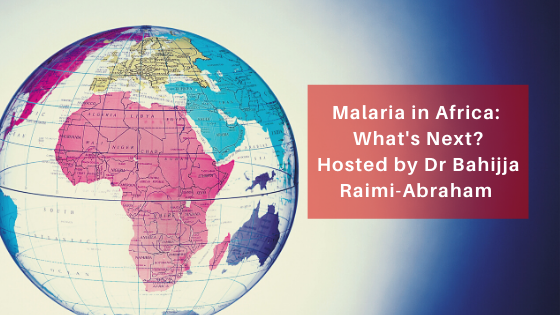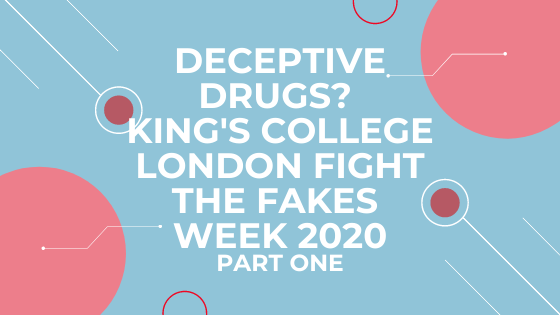
On Tuesday 29th October, we were lucky enough to be invited by Dr Bahijja Raimi-Abraham (Lecturer in Pharmaceutics at King’s College London) to her event; “Malaria in Africa: What’s next?” a symposium on the current status of malaria in Africa, and the next steps in tackling the disease. We heard some fascinating talks and learned a lot about malarial infection, treatment and future challenges, so read on for our key takeaways from the event!
In 2017, there were approximately 219 million cases of malaria across the globe, with the estimated number of deaths at 435,000. The majority of global malarial deaths (around 90%) occur on the African continent. The fact that Africa carries the bulk of the world’s malaria burden is even more concerning coupled with the fact that, by 2050, almost half of the world’s poorest people will be located in two African countries; Nigeria and the Democratic Republic of Congo.

Dr Raimi-Abraham opened the event by highlighting her journey to investigate the true burden of Malaria in Africa more specifically in Nigeria and Ghana (West Africa). Dr Raimi-Abraham was appointed Lecturer at King’s College London in 2017 and has been developing a new research direction focused on solving pharmaceutical challenges in ageing and global health.
Helen Counihan from the Malaria Consortium provided an overview of the organisation’s activities and the remainder of her talk focused on the consortium’s ongoing work in Nigeria. Helen is Malaria Consortium’s Head of Technical for West and Central Africa, providing leadership and support to the charity’s community-based work.

One major challenge that Helen noted is the rise of insecticide resistance, suggesting that equipment such as mosquito nets are becoming less efficient at controlling the spread of malaria. She also spoke about the Seasonal Malaria Chemoprevention (SMC) measures that are deployed in some regions. The programme involves the administration of anti-malarial drugs to children under five living in areas affected by seasonal bouts of malaria, usually during the rainy seasons. Since the introduction of SMC by the World Health Organisation in 2012, the Malaria Consortium has been a pioneer of the preventative therapy, beginning with a pilot scheme in Nigeria, and more recently, expanding to The Gambia, Burkina Faso, Niger, amongst other regions. One of the key roles of the Malaria Consortium is ensuring a smooth flow of anti-malarial drugs through government supply chains, as delays can be catastrophic in disrupting the intermittent administration of medicines.

Dr Diane Ashiru-Oredope, who is the Lead Pharmacist, AMR & HCAI division, National Infection Service, Public Health England and Global AMR Lead, Commonwealth Pharmacist Association, spoke about the interlinked issues of drug resistance and co-infection. When we think of antimicrobial resistance (AMR), we often think of bacterial resistance, however, other microbes, including the malaria parasite, can also develop resistance, and research is needed to ensure we can understand and tackle this problem. Diane pointed out that, shockingly, by 2050, there will be more deaths due to drug-resistant infections than cancer. Coinfection with other illnesses is also a big issue in malaria research. One of the main diseases that coincides with malarial infection is tuberculosis (T.B), which affected 9.6 million people worldwide in 2014, and is one of the top ten causes of death, globally. In the UK, there is a T.B strategy in place, which includes improving access to health services and improving standards of T.B care generally. Another important factor is determining sources of T.B, in a process known as contact tracing, in which healthcare professionals go out into the community to find out who infected who, and offer preventative treatments to people who have come into contact with them, to reduce the spread of T.B.
Diane also highlighted the fact that cases of multi-drug resistant T.B are also on the rise, and in light of the general increase in AMR diseases, in 2016, 193 countries signed a U.N declaration to tackle the problem of drug resistance. This has led to several initiatives, such as World Antibiotic Resistance Awareness Week, as well as finding for the generation and analysis of AMR databases. The work of the Commonwealth Pharmacy Association is also crucial, comprising some of the poorest nations in the world, and works to ensure safe and effective medication management, reduction in health inequality, and a decrease in adverse drug effects; placing pharmacists at the forefront of global health.

Dr Cynthia Amaning Danquah, senior lecturer at Kwame Nkrumah University of Science and Technology gave a Ghanaian perspective to the problem of malaria. In 2018, Ghana launched an action plan to tackle AMR, aiming to reduce Ghana’s malaria morbidity rate by 75% by 2020. The objectives of the scheme include the protection of 80% of the at-risk population, provision of rapid diagnosis, as well as raising awareness. The use of Artemisinin-based combination (ACT) therapy has been widely used as an anti-malarial treatment in Ghana for several years, with the combination of different drugs becoming necessary due to increasing resistance. Cynthia also discussed the issue of reluctance to trust medical treatments and the preference for more traditional, herbal remedies, which she pointed out is not simply down to a difference in beliefs, but also has practical causes, as herbal medicines are often much cheaper and more easily accessible than antimalarial treatments. Another key problem is that of ‘presumptive malaria’, whereby doctors prescribe antimalarials at the first sign of symptoms such as fever, which can be caused by several illnesses and is not always due to malaria, hence, this can be another source of AMR.

Dr Joshua Obasanya, Director of the Prevention and Programs Coordination Department at the Nigeria Centre for Disease Control, provided an insight into malaria in Nigeria. Shockingly, the country accounts for 25% of malaria cases worldwide, and 19% of global malaria deaths. In light of these horrifying statistics, the National Reference Laboratory (check) was set up in 2017, providing tools for the diagnosis of malaria, as well as other diseases such as cholera and Lassa fever, largely via genomic sequencing methods. The Nigeria Centre for Disease Control is also aiming to deploy surveillance programmes in all Nigerian states by 2020, as well as implementing protocols such as integrated vector management, and investigation into comorbidities of malaria with other illnesses, particularly respiratory infections such as typhoid. As Joshua highlighted, the key to tackling malaria in Nigeria is to bring together experts from different fields and to combine resources.
Key takeaways from the event:
- Malaria is multifaceted, with issues such as coinfection, AMR and public perceptions compounding the problem
- Much of the worlds malarial burden is in Africa – needs to be the focal point going forwards
- Global health is becoming an increasingly multi-disciplined field – no longer just for doctors and nurses, but pharmacists are playing key roles now
The event was a real eye-opener, not just in revealing the disease mechanisms of malaria, but in demonstrating the layers of the world’s malaria burden, from AMR to the difficulties in convincing patients to rely on pharmaceutical drugs rather than traditional remedies. We certainly learnt a lot, and we hope this summary teaches you something new too!
Visit the #MalariaWhatsNext hashtag on Twitter to see more highlights from the event!




